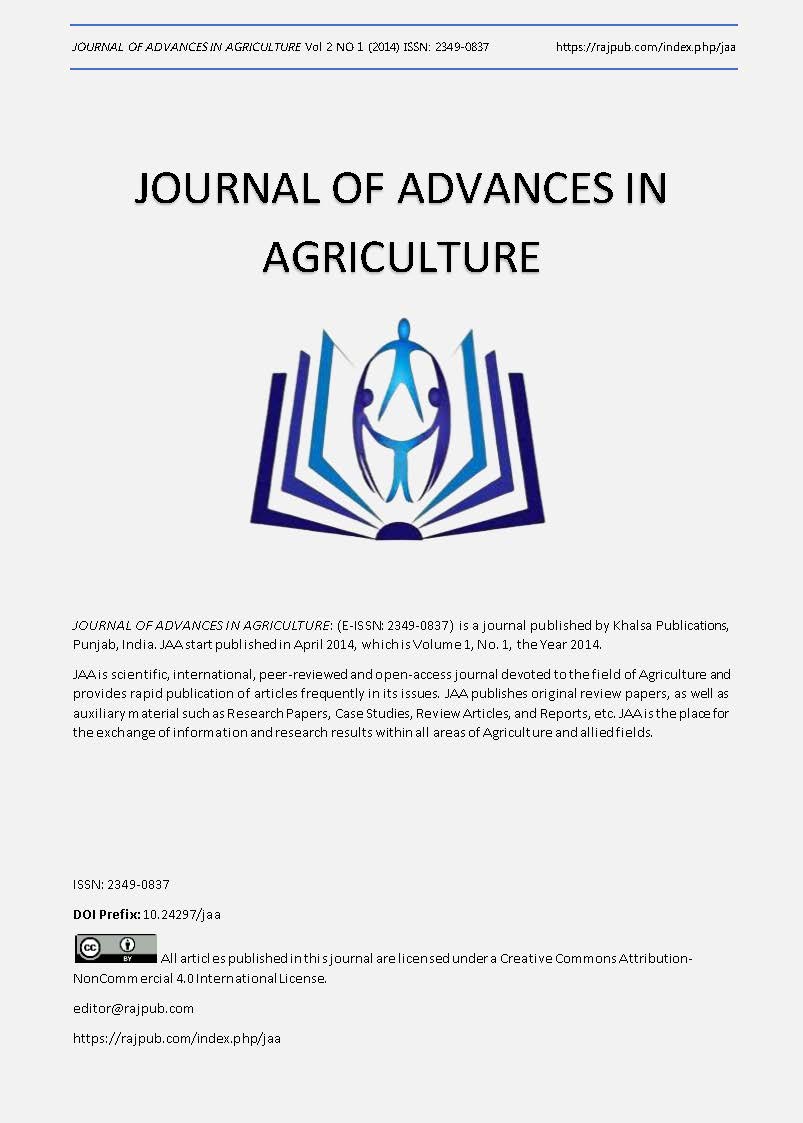A study on pre-retting and post-retting water of waterbodies from a selected area of Bangladesh
DOI:
https://doi.org/10.24297/jaa.v2i1.4252Keywords:
retting, jute, pollution, Bangladesh.Abstract
The study was conducted to analyze the pre and post-retting water of five randomly selected ponds regarding the parameters viz. BOD5, COD, TSS, TDS, TKN, TP, CI, PH, Ec PH, and EC. BOD5 (ranging from 110 to 215 mg/l and 170 to 237 mg/l, respectively)and COD (227 mg/l to 310 and 299 to 403 mg/l, respectively)values of both pre and post-retting water of all the ponds were much higher than recommended values. Values of TSS, TKN, TP tests of both pre and post-retting water of the ponds reflected higher values than recommended values. Whereas, TDS(213 to 501 mg/l and 210 to 595 mg/l, respectively) and Cl (51 to 300mg/l and 50 to 305 mg/l, respectively) values were less than recommended values. PH values were within the recommended range of PH 6 to PH 9. All these results indicates that jute-retting is may not be the one and only factor to deteriorate the water quality of ponds. Jute-retting causes transitory water pollution in the water bodies only which can be minimized or removed by different ways. To find out specific way(s) to minimize or eradicate this transitory pollution further research is required.
Downloads
References
Ahmad, M. 2008. Studies on Jute Retting Bacteria. J. Applied Microbiology. 26: 117–126.
Ali MM, Choudhury SD (1962). Pectic enzymes in Jute retting. Pakistan. J. Sci. Indus.Res.5:271-273.
Ali MM, Sayem AZM, Eshaque AKM (1970). Effect of neutralization of retting liquor on the progress of retting. Science and Industry. 7:134-136.
Ali MM, Alam S, Eshaque AKM, Khandakar AL (1972). Effect of urea on the bacterial flora, acidity and total nitrogen of jute retting water. Nuclear Sci. Appl. 6: 85-87.
Ali MM, Alam S (1973). Effect of different pH values on Jute retting. Bangladesh J. Bot. 2: 19-23.
Amin AFMS, Shamsuddin AJ and Alam MM.1998. Optimization of sewage treatment process in Pagla.24th WEDC conference, Islamabad, Pakistan. pp.129-135.
A.P.H.A., 1992, Standard method for the examination of water and wastewater, 14 th edition, American Public Health Association NY.
Bakar MA, Taimur R, Islam S, Kabir A, and Bhuiyan HR, 2010. Study of pollution level of four canals of Chittagong. J. Subtrop. Agric. Res. Dev. 8(1 to 6): pp. 755-758.
Bangladesh Gazette, 1997, 1st edition, Ministry of Environment and Forest, Government of Peoples Republic of Bangladesh, amended by notifications : SRO 29-Law/2002, SRO 234-Law/2002, SRO 88-Law/2003.
Das ND,. 2002. Water quality characterization of the Bhairab Rupsha River systems of Khulna city. B.Sc Thesis, pp27-30.
Haque MS, Zakaria A, Asaduzzaman M, Quashem MA and Firoz A .2002. Distribution and activity of microbial population for jute retting and their impact as water of jute growing areas of Bangladesh. Pakistan Journal of Biological Science, 5(6):704-706.
IJO.1994. IJO-FAO project on improved retting and extraction of Jute. GCP/ RAS/ 122/IJO/53. PP. 6-7.
Ramesh R and Anbu M., 1996. Chemical Methods for Environmental Analysis- Water and Sediment.
Rahman A, 2002, Waste water treatment systwms of some textile dyeing and finishing mills in Bangladesh. B Sc Thesis, pp. 15-21.
Downloads
Published
How to Cite
Issue
Section
License
 All articles published in Journal of Advances in Linguistics are licensed under a Creative Commons Attribution 4.0 International License.
All articles published in Journal of Advances in Linguistics are licensed under a Creative Commons Attribution 4.0 International License.




